Sustainability of a Rainfed Wheat Production System in Relation to Water and Nitrogen Dynamics in the Soil in the Eyre Peninsula, South Australia
Abstract
:1. Introduction
2. Materials and Methods
2.1. Description of Study Sites
2.2. Climate Parameters
2.3. Brief Description of HYDRUS-1D
2.4. Nitrogen Balance Parameters
2.5. Initial and Boundary Conditions
2.6. Model Evaluation
3. Results
3.1. Soil Water Dynamics in the Soil
3.2. Soil Water Balance
3.3. Nitrogen Simulation in the Soils
3.4. Nitrogen Balance in Soils
3.4.1. Mineralization of Organic N in the Soil
3.4.2. Nitrogen Uptake by Wheat
3.4.3. Simulated Volatilization Losses of N
3.4.4. Leaching Losses of Nitrogen
3.5. Water Productivity and N Use Efficiency
4. Discussion
4.1. Soil Water Balance and Wheat Water Uptake
4.2. Nitrogen Losses and Recovery by Crop
5. Conclusions
Supplementary Materials
Author Contributions
Funding
Institutional Review Board Statement
Informed Consent Statement
Data Availability Statement
Acknowledgments
Conflicts of Interest
References
- Angus, J.F.; Grace, P.R. Nitrogen balance in Australia and nitrogen use efficiency on Australian farms. Soil Res. 2017, 55, 435–450. [Google Scholar] [CrossRef]
- Sadras, V.O.; Denison, R.F. Neither crop genetics nor crop management can be optimised. Field Crops Res. 2016, 189, 75–83. [Google Scholar] [CrossRef]
- Connor, D.J. Designing cropping systems for efficient use of limited water in southern Australia. Eur. J. Agron. 2004, 21, 419–431. [Google Scholar] [CrossRef]
- Sadras, V.O.; Rodriguez, D. Modelling the nitrogen-driven trade-off between nitrogen utilisation efficiency and water use efficiency of wheat in eastern Australia. Field Crops Res. 2010, 118, 297–305. [Google Scholar] [CrossRef]
- Cawood, R.M. (Ed.) Climate of south-eastern Australia. In Climate, Temperature and Crop Production in South-Eastern Australia; Principles of Sustainable Agriculture; Agriculture Victoria: Horsham, Australia, 1996; pp. 21–33. [Google Scholar]
- Unkovich, M.; McBeath, T.; Llewellyn, R.; Hall, J.; Gupta, V.V.S.R.; Macdonald, L.M. Challenges and opportunities for grain farming on sandy soils of semi-arid south and south-eastern Australia. Soil Res. 2020, 58, 323–334. [Google Scholar] [CrossRef]
- ABARES. Wheat Forecast 20-22-23 Season; Department of Agriculture, Fisheries and Forestry, Australian Government: Canberra, Australia, 2023. [Google Scholar]
- Hochman, Z.; Gobbett, D.; Horan, H.; Garcia, J.N. Data rich yield gap analysis of wheat in Australia. Field Crops Res. 2016, 197, 97–106. [Google Scholar] [CrossRef]
- Bodner, G.; Nakhforoosh, A.; Kaul, H.-P. Management of crop water under drought: A review. Agron. Sustain. Dev. 2015, 35, 401–442. [Google Scholar] [CrossRef]
- French, R.; Schultz, J. Water use efficiency of wheat in a Mediterranean-type environment. I. The relation between yield, water use and climate. Aust. J. Agric. Res. 1984, 35, 743–764. [Google Scholar] [CrossRef]
- Sadras, V.O.; Angus, J.F. Benchmarking water-use efficiency of rainfed wheat in dry environments. Aust. J. Agric. Res. 2006, 57, 847–856. [Google Scholar] [CrossRef]
- Sadras, V.O.; Rodriguez, D. The limit to wheat water-use efficiency in eastern Australia. II. Influence of rainfall patterns. Aust. J. Agric. Res. 2007, 58, 657–669. [Google Scholar] [CrossRef]
- Hochman, Z.; Gobbett, D.L.; Horan, H. Climate trends account for stalled wheat yields in Australia since 1990. Glob. Chang. Biol 2017, 23, 2071–2081. [Google Scholar] [CrossRef]
- Sadras, V.O.; Lawson, C. Nitrogen and water-use efficiency of Australian wheat varieties released between 1958 and 2007. Eur. J. Agron. 2013, 46, 34–41. [Google Scholar] [CrossRef]
- Angus, J.F.; van Herwaarden, A.F. Increasing Water Use and Water Use Efficiency in Dryland Wheat. Agron. J. 2001, 93, 290–298. [Google Scholar] [CrossRef]
- Keating, B.A.; Carberry, P.S.; Hammer, G.L.; Probert, M.E.; Robertson, M.J.; Holzworth, D.P.; Huth, N.I.; Hargreaves, J.N.G.; Meinke, H.; Hochman, Z.; et al. An overview of APSIM, a model designed for farming systems simulation. Eur. J. Agron. 2003, 18, 267–288. [Google Scholar] [CrossRef]
- Šimůnek, J.; van Genuchten, M.T.; Sejna, M. Recent developments and applications of the HYDRUS computer software packages. Vadose Zone J. 2016, 15, 1–25. [Google Scholar] [CrossRef]
- Li, S.-X.; Wang, Z.-H.; Malhi, S.S.; Li, S.-Q.; Gao, Y.-J.; Tian, X.-H. Chapter 7 Nutrient and Water Management Effects on Crop Production, and Nutrient and Water Use Efficiency in Dryland Areas of China. Adv. Agron. 2009, 102, 223–265. [Google Scholar]
- Cossani, C.M.; Slafer, G.A.; Savin, R. Co-limitation of nitrogen and water, and yield and resource-use efficiencies of wheat and barley. Crop Pasture Sci. 2010, 61, 844–851. [Google Scholar] [CrossRef]
- Wang, Z.-H.; Li, S.-X. Nitrate N loss by leaching and surface runoff in agricultural land: A global issue (a review). Adv. Agron. 2019, 156, 159–217. [Google Scholar]
- Osman, R.; Tahir, M.N.; Ata-Ul-Karim, S.T.; Ishaque, W.; Xu, M. Exploring the Impacts of Genotype-Management-Environment Interactions on Wheat Productivity, Water Use Efficiency, and Nitrogen Use Efficiency under Rainfed Conditions. Plants 2021, 10, 2310. [Google Scholar] [CrossRef] [PubMed]
- Benjamin, J.G.; Porter, L.K.; Duke, H.R.; Ahuja, L.R. Corn Growth and Nitrogen Uptake with Furrow Irrigation and Fertilizer Bands. Agron. J. 1997, 89, 609–612. [Google Scholar] [CrossRef]
- Lehrsch, G.; Sojka, R.; Westermann, D. Furrow irrigation and N management strategies to protect water quality. Commun. Soil Sci. Plant Anal. 2001, 32, 1029–1050. [Google Scholar] [CrossRef]
- Smith, C.J.; Hunt, J.R.; Wang, E.; Macdonald, B.C.T.; Xing, H.; Denmead, O.T.; Zeglin, S.; Zhao, Z. Using fertiliser to maintain soil inorganic nitrogen can increase dryland wheat yield with little environmental cost. Agric. Ecosyst. Environ. 2019, 286, 106644. [Google Scholar] [CrossRef]
- Keller, G.D.; Mengel, D.B. Ammonia Volatilization from Nitrogen Fertilizers Surface Applied to No-till Corn. Soil Sci. Soc. Am. J. 1986, 50, 1060–1063. [Google Scholar] [CrossRef]
- Chien, S.; Prochnow, L.; Cantarella, A.H. Recent developments of fertilizer production and use to improve nutrient efficiency and minimize environmental impacts. Adv. Agron. 2009, 102, 267–322. [Google Scholar]
- Turner, D.A.; Edis, R.E.; Chen, D.; Freney, J.R.; Denmead, O.T. Ammonia volatilization from nitrogen fertilizers applied to cereals in two cropping areas of southern Australia. Nutr. Cycl. Agroecosystems 2012, 93, 113–126. [Google Scholar] [CrossRef]
- Gastal, F.; Lemaire, G.; Durand, J.-L.; Louarn, G. Chapter 8—Quantifying crop responses to nitrogen and avenues to improve nitrogen-use efficiency. In Crop Physiology, 2nd ed.; Sadras, V.O., Calderini, D.F., Eds.; Academic Press: San Diego, CA, USA, 2015; pp. 161–206. [Google Scholar]
- Raun, W.R.; Johnson, G.V. Improving Nitrogen Use Efficiency for Cereal Production. Agron. J. 1999, 91, 357–363. [Google Scholar] [CrossRef]
- Kubar, M.S.; Alshallash, K.S.; Asghar, M.A.; Feng, M.; Raza, A.; Wang, C.; Saleem, K.; Ullah, A.; Yang, W.; Kubar, K.A.; et al. Improving Winter Wheat Photosynthesis, Nitrogen Use Efficiency, and Yield by Optimizing Nitrogen Fertilization. Life 2022, 12, 1478. [Google Scholar] [CrossRef]
- Galloway, J.N.; Townsend, A.R.; Erisman, J.W.; Bekunda, M.; Cai, Z.; Freney, J.R.; Martinelli, L.A.; Seitzinger, S.P.; Sutton, M.A. Transformation of the Nitrogen Cycle: Recent Trends, Questions, and Potential Solutions. Science 2008, 320, 889–892. [Google Scholar] [CrossRef]
- Powlson, D.S.; Addiscott, T.M.; Benjamin, N.; Cassman, K.G.; de Kok, T.M.; van Grinsven, H.; L’Hirondel, J.L.; Avery, A.A.; van Kessel, C. When does nitrate become a risk for humans? J. Environ. Qual. 2008, 37, 291–295. [Google Scholar] [CrossRef]
- Asseng, S.; Ewert, F.; Rosenzweig, C.; Jones, J.W.; Hatfield, J.L.; Ruane, A.C.; Boote, K.J.; Thorburn, P.J.; Rötter, R.P.; Cammarano, D.; et al. Uncertainty in simulating wheat yields under climate change. Nat. Clim. Chang. 2013, 3, 827–832. [Google Scholar] [CrossRef]
- Ishaque, W.; Osman, R.; Hafiza, B.S.; Malghani, S.; Zhao, B.; Xu, M.; Ata-Ul-Karim, S.T. Quantifying the impacts of climate change on wheat phenology, yield, and evapotranspiration under irrigated and rainfed conditions. Agric. Water Manag. 2023, 275, 108017. [Google Scholar] [CrossRef]
- Gonzalez-Dugo, V.; Durand, J.-L.; Gastal, F. Water deficit and nitrogen nutrition of crops. A review. Agron. Sustain. Dev. 2010, 30, 529–544. [Google Scholar] [CrossRef]
- Norton, R.; Walker, C.; Farlow, C. Nitrogen removal and use on a long-term fertilizer experiment. In Proceedings of the 17th Australian Society of Agronomy Conference, Hobrt, Australia, 20–24 September 2015. [Google Scholar]
- Phogat, V.; Skewes, M.A.; Cox, J.W.; Sanderson, G.; Alam, J.; Šimůnek, J. Seasonal simulation of water, salinity and nitrate dynamics under drip irrigated mandarin (Citrus reticulata) and assessing management options for drainage and nitrate leaching. J. Hydrol. 2014, 513, 504–516. [Google Scholar] [CrossRef]
- Gaydon, D.S.; Balwinder, S.; Wang, E.; Poulton, P.L.; Ahmad, B.; Ahmed, F.; Akhter, S.; Ali, I.; Amarasingha, R.; Chaki, A.K.; et al. Evaluation of the APSIM model in cropping systems of Asia. Field Crops Res. 2017, 204, 52–75. [Google Scholar] [CrossRef]
- Ware, A.; Spriggs, B.; Budarick, S.; Scholz, N. Delivering Value from Soil Moisture Probes on Eyre Peninsula; Minnipa Agriculture Centre: Minnipa, Australia, 2020. [Google Scholar]
- Fabio, A.; Cook, A.; Richter, I.; King, N. Benchmarking Water Limited Yield of Cereal Crops on Major Soil Types across Eyre Peninsula; Minnipa Agriculture Centre: Minnipa, Australia, 2019. [Google Scholar]
- Rayment, G.E.; Lyons, D.J.; Shelley, B. Soil Chemical Methods—Australasia: Australasia; CSIRO Publishing: Clayton, Australia, 2011. [Google Scholar]
- ASRIS. Australian Soil Resource Information System. 2011. Available online: http://www.asris.csiro.au (accessed on 30 August 2023).
- Jeffrey, S.J.; Carter, J.O.; Moodie, K.B.; Beswick, A.R. Using spatial interpolation to construct a comprehensive archive of Australian climate data. Environ. Model. Softw. 2001, 16, 309–330. [Google Scholar] [CrossRef]
- Allen, R.G.; Pereira, L.S.; Raes, D.; Smith, M. Crop Evapotranspiration: Guidelines for Computing Crop Water Requirements; FAO: Rome, Italy, 1998. [Google Scholar]
- Ritchie, J.T. Model for predicting evaporation from a row crop with incomplete cover. Water Resour. Res. 1972, 8, 1204–1213. [Google Scholar] [CrossRef]
- Miralles, D.J.; Slafer, G.A. Radiation interception and radiation use efficiency of near-isogenic wheat lines with different height. Euphytica 1997, 97, 201–208. [Google Scholar] [CrossRef]
- Feddes, R.A.; Kowalik, P.J.; Zaradny, H. Simulation of Field Water Use and Crop Yield; Pudoc for the Centre for Agricultural Publishing and Documentation: Wageningen, The Netherlands, 1978. [Google Scholar]
- Nakasone, H.; Abbas, M.A.; Kuroda, H. Nitrogen transport and transformation in packed soil columns from paddy fields. Paddy Water Environ. 2004, 2, 115–124. [Google Scholar] [CrossRef]
- Baldock, J.; Macdonald, L.; Farrell, M.; Welti, N.; Monjardino, M. Nitrogen Dynamics in Modern Cropping Systems; Grain Research and Development Corporation: Barton, Australia, 2018. [Google Scholar]
- Barton, L.; Hoyle, F.C.; Stefanova, K.T.; Murphy, D.V. Incorporating organic matter alters soil greenhouse gas emissions and increases grain yield in a semi-arid climate. Agric. Ecosyst. Environ. 2016, 231, 320–330. [Google Scholar] [CrossRef]
- Yang, Y.; Tong, Y.; Gao, P.; Htun, Y.M.; Feng, T. Evaluation of N(2)O emission from rainfed wheat field in northwest agricultural land in China. Environ. Sci. Pollut. Res. Int. 2020, 27, 43466–43479. [Google Scholar] [CrossRef]
- Li, Y.; Šimůnek, J.; Zhang, Z.; Jing, L.; Ni, L. Evaluation of nitrogen balance in a direct-seeded-rice field experiment using Hydrus-1D. Agric. Water Manag. 2015, 148, 213–222. [Google Scholar] [CrossRef]
- Phogat, V.; Mahalakshmi, M.; Skewes, M.; Cox, J.W. Modelling soil water and salt dynamics under pulsed and continuous surface drip irrigation of almond and implications of system design. Irrig. Sci. 2012, 30, 315–333. [Google Scholar] [CrossRef]
- Renard, J.J.; Calidonna, S.E.; Henley, M.V. Fate of ammonia in the atmosphere—A review for applicability to hazardous releases. J. Hazard. Mater. 2004, 108, 29–60. [Google Scholar] [CrossRef] [PubMed]
- Wang, S.; Chen, J. Study on the integrated distribution coefficient of ammonium N migration in layered soil. Environ. Sci. Pollut. Res. Int. 2020, 27, 25340–25352. [Google Scholar] [CrossRef]
- Chowdary, V.M.; Rao, N.H.; Sarma, P.B.S. A coupled soil water and nitrogen balance model for flooded rice fields in India. Agric. Ecosyst. Environ. 2004, 103, 425–441. [Google Scholar] [CrossRef]
- Yadav, D.; Kumar, V.; Singh, M.; Relan, P. Effect of temperature and moisture on kinetics of urea hydrolysis and nitrification. Soil Res. 1987, 25, 185–191. [Google Scholar] [CrossRef]
- Šimůnek, J.; Hopmans, J.W. Modeling compensated root water and nutrient uptake. Ecol. Model. 2009, 220, 505–521. [Google Scholar] [CrossRef]
- Jury, W.A.; Spencer, W.F.; Farmer, W.J. Behavior Assessment Model for Trace Organics in Soil: I. Model Description. J. Environ. Qual. 1983, 12, 558–564. [Google Scholar] [CrossRef]
- Adcock, D. Soil Water and Nitrogen Dynamics of Farming Systems on the upper Eyre Peninsula, South Australia. Ph.D. Thesis, School of Earth and Environmental Sciences, University of Adelaide, Adelaide, Australia, 2005. [Google Scholar]
- Wang, X.; Cai, H.; Li, L.; Wang, X. Estimating Soil Water Content and Evapotranspiration of Winter Wheat under Deficit Irrigation Based on SWAP Model. Sustainability 2020, 12, 9451. [Google Scholar] [CrossRef]
- Ramos, T.B.; Šimůnek, J.; Gonçalves, M.C.; Martins, J.C.; Prazeres, A.; Pereira, L.S. Two-dimensional modeling of water and nitrogen fate from sweet sorghum irrigated with fresh and blended saline waters. Agric. Water Manag. 2012, 111, 87–104. [Google Scholar] [CrossRef]
- Evett, S.R.; Schwartz, R.C.; Casanova, J.J.; Heng, L.K. Soil water sensing for water balance, ET and WUE. Agric. Water Manag. 2012, 104, 1–9. [Google Scholar] [CrossRef]
- Shafeeq, P.M.; Aggarwal, P.; Krishnan, P.; Rai, V.; Pramanik, P.; Das, T.K. Modeling the temporal distribution of water, ammonium-N, and nitrate-N in the root zone of wheat using HYDRUS-2D under conservation agriculture. Environ. Sci. Pollut. Res. Int. 2020, 27, 2197–2216. [Google Scholar] [CrossRef] [PubMed]
- Wallace, A.J.; Armstrong, R.D.; Grace, P.R.; Scheer, C.; Partington, D.L. Nitrogen use efficiency of 15N urea applied to wheat based on fertiliser timing and use of inhibitors. Nutr. Cycl. Agroecosystems 2020, 116, 41–56. [Google Scholar] [CrossRef]
- Fenn, L.B.; Miyamoto, S. Ammonia Loss and Associated Reactions of Urea in Calcareous Soils. Soil Sci. Soc. Am. J. 1981, 45, 537–540. [Google Scholar] [CrossRef]
- Freney, J.R.; Simpson, J.R.; Denmead, O.T. Volatilization of ammonia. In Gaseous Loss of Nitrogen from Plant-Soil Systems; Freney, J.R., Simpson, J.R., Eds.; Springer: The Hague, The Netherlands, 1983. [Google Scholar]
- Hu, C.; Zheng, C.; Sadras, V.O.; Ding, M.; Yang, X.; Zhang, S. Effect of straw mulch and seeding rate on the harvest index, yield and water use efficiency of winter wheat. Sci. Rep. 2018, 8, 8167. [Google Scholar] [CrossRef] [PubMed]
- White, R.G.; Kirkegaard, J.A. The distribution and abundance of wheat roots in a dense, structured subsoil—Implications for water uptake. Plant Cell Environ. 2010, 33, 133–148. [Google Scholar] [CrossRef]
- Zhang, S.; Sadras, V.; Chen, X.; Zhang, F. Water use efficiency of dryland wheat in the Loess Plateau in response to soil and crop management. Field Crops Res. 2013, 151, 9–18. [Google Scholar] [CrossRef]
- Lollato, R.P.; Edwards, J.T.; Ochsner, T.E. Meteorological limits to winter wheat productivity in the U.S. southern Great Plains. Field Crops Res. 2017, 203, 212–226. [Google Scholar] [CrossRef]
- Harries, M.; Flower, K.C.; Renton, M.; Anderson, G.C. Water use efficiency in Western Australian cropping systems. Crop Pasture Sci. 2022, 73, 1097–1117. [Google Scholar] [CrossRef]
- Bogunović, I.; Filipović, V. Mulch as a nature-based solution to halt and reverse land degradation in agricultural areas. Curr. Opin. Environ. Sci. Health 2023, 34, 100488. [Google Scholar] [CrossRef]
- Krevh, V.; Filipović, L.; Petošić, D.; Mustać, I.; Bogunović, I.; Butorac, J.; Kisić, I.; Defterdarović, J.; Nakić, Z.; Kovač, Z.; et al. Long-term analysis of soil water regime and nitrate dynamics at agricultural experimental site: Field-scale monitoring and numerical modeling using HYDRUS-1D. Agric. Water Manag. 2023, 275, 108039. [Google Scholar] [CrossRef]
- Hochman, Z.; Horan, H. Causes of wheat yield gaps and opportunities to advance the water-limited yield frontier in Australia. Field Crops Res. 2018, 228, 20–30. [Google Scholar] [CrossRef]
- Angus, J.F.; van Herwaarden, A.F.; Fischer, R.A.; Howe, G.N.; Heenan, D.P. The source of mineral nitrogen for cereals in south-eastern Australia. Aust. J. Agric. Res. 1998, 49, 511–522. [Google Scholar] [CrossRef]
- Cameron, K.C.; Di, H.J.; Moir, J.L. Nitrogen losses from the soil-plant system: A review. Ann. Appl. Biol. 2013, 162, 145–173. [Google Scholar] [CrossRef]
- Monjardino, M.; Hochman, Z.; Horan, H. Yield potential determines Australian wheat growers’ capacity to close yield gaps while mitigating economic risk. Agron. Sustain. Dev. 2019, 39, 49. [Google Scholar] [CrossRef]
- IPCC. Guidelines for National Greenhouse Gas Inventories; Intergovernmental Panel on Climate Change: Geneva, Switzerland, 2006. [Google Scholar]
- Siemens, J.; Kaupenjohann, M. Contribution of dissolved organic nitrogen to N leaching from four German agricultural soils. J. Plant Nutr. Soil Sci. 2002, 165, 675–681. [Google Scholar] [CrossRef]
- Anderson, G.C.; Fillery, I.R.P.; Dunin, F.X.; Dolling, P.J.; Asseng, S. Nitrogen and water flows under pasture-wheat and lupin-wheat rotations in deep sands in Western Australia 2. Drainage and nitrate leaching. Aust. J. Agric. Res. 1998, 49, 345–361. [Google Scholar] [CrossRef]
- Poss, R.; Smith, C.J.; Dunin, F.X.; Angus, J.F. Rate of soil acidification under wheat in a semi-arid environment. Plant Soil 1995, 177, 85–100. [Google Scholar] [CrossRef]
- Ridley, A.M.; White, R.E.; Helyar, K.R.; Morrison, G.R.; Heng, L.K.; Fisher, R. Nitrate leaching loss under annual and perennial pastures with and without lime on a duplex (texture contrast) soil in humid southeastern Australia. Eur. J. Soil Sci. 2001, 52, 237–252. [Google Scholar] [CrossRef]
- Ridley, A.M.; Mele, P.M.; Beverly, C.R. Legume-based farming in Southern Australia: Developing sustainable systems to meet environmental challenges. Soil Biol. Biochem. 2004, 36, 1213–1221. [Google Scholar] [CrossRef]
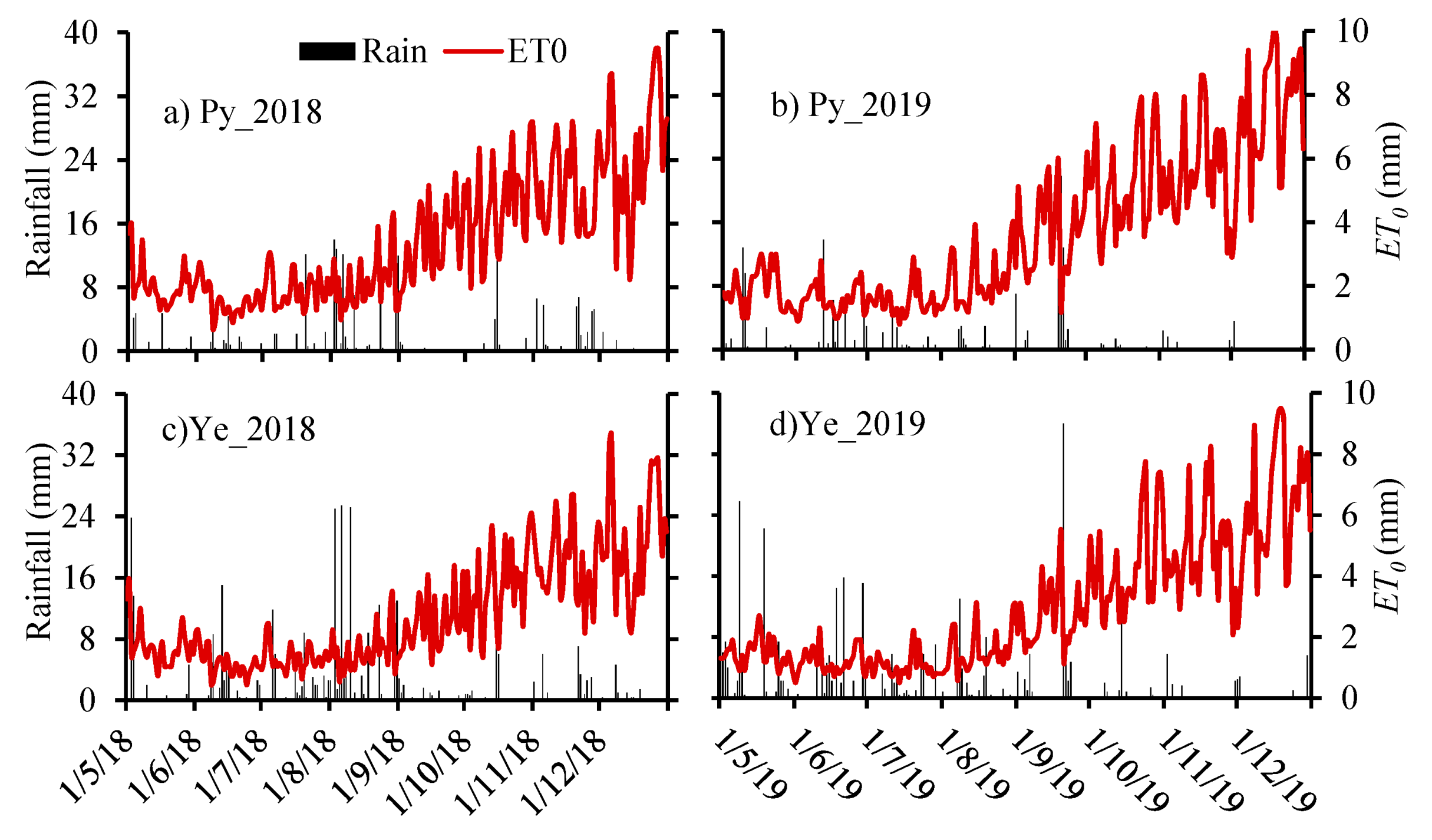

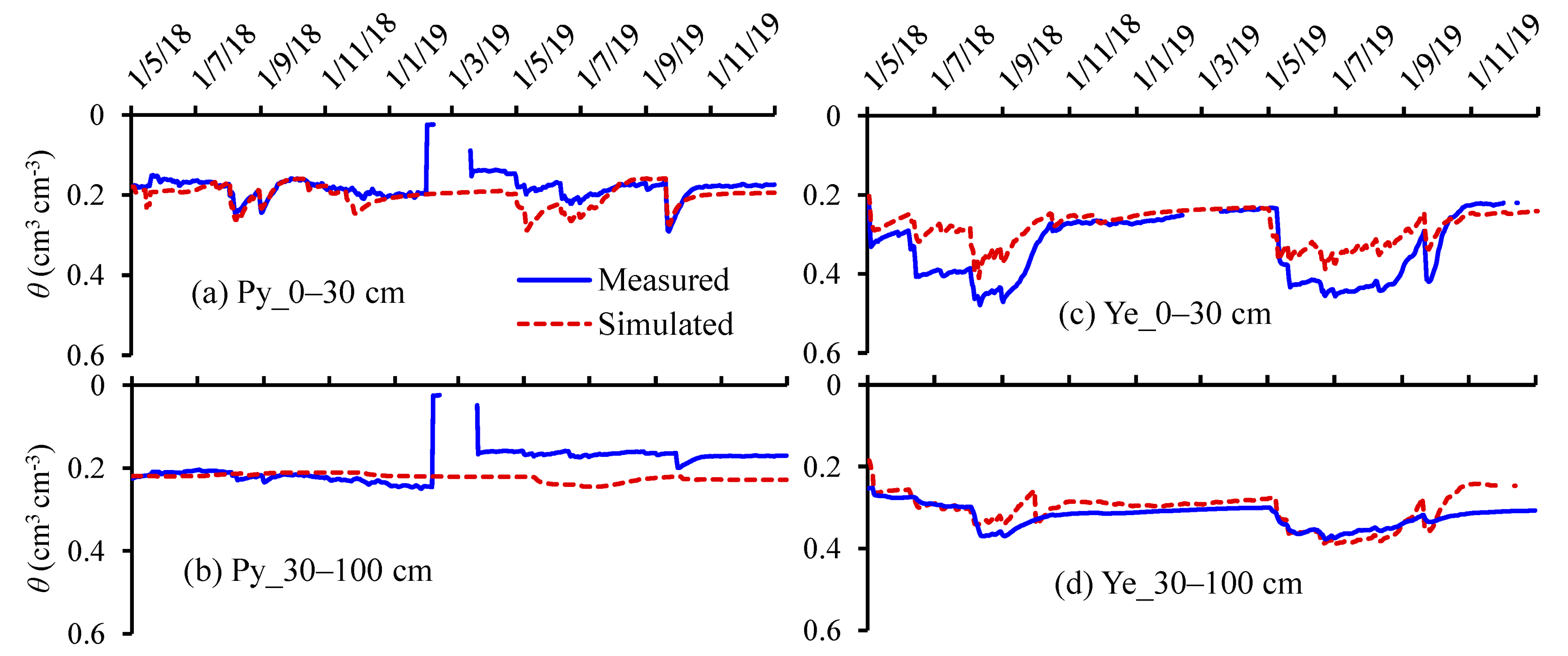
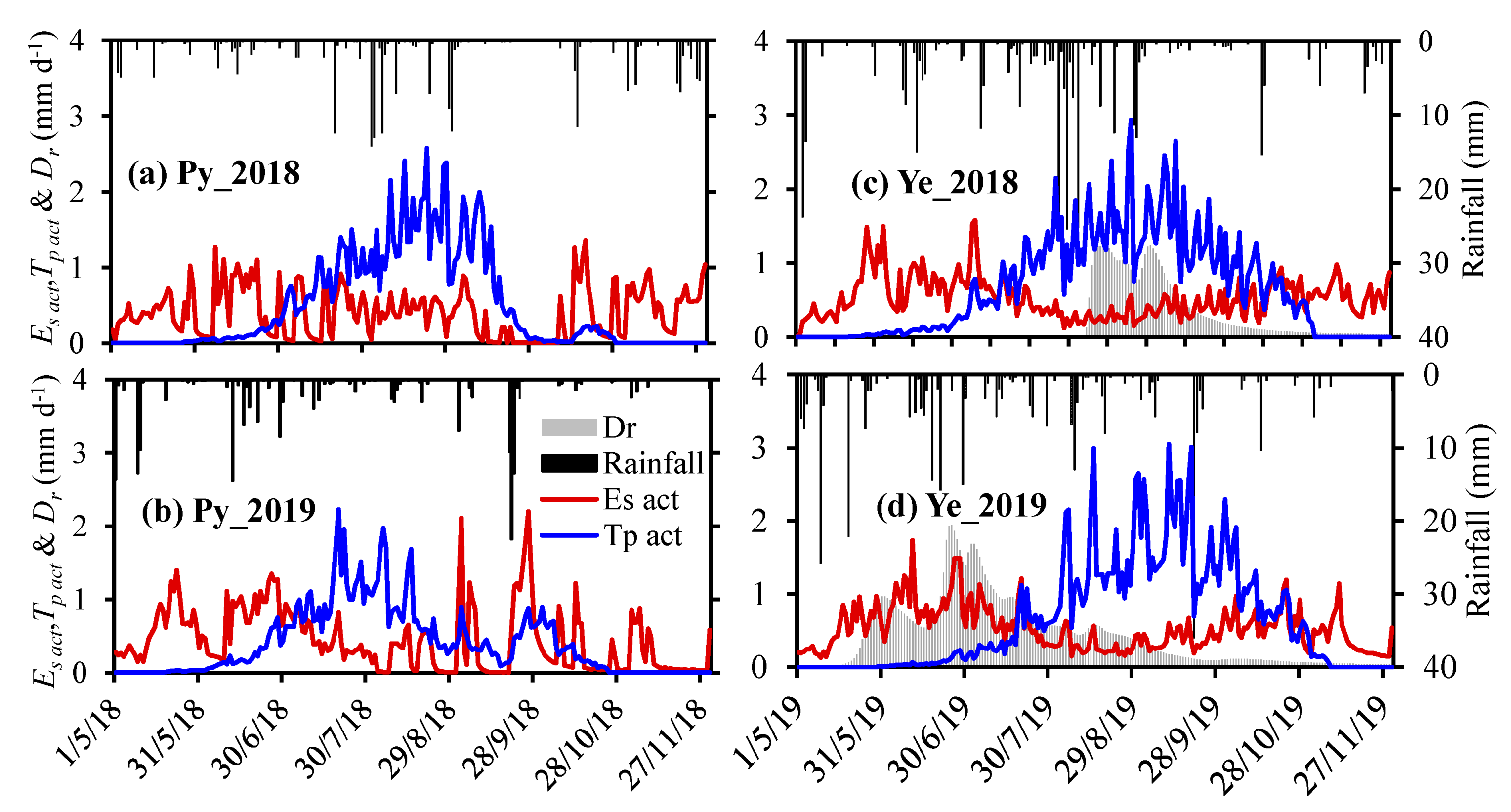

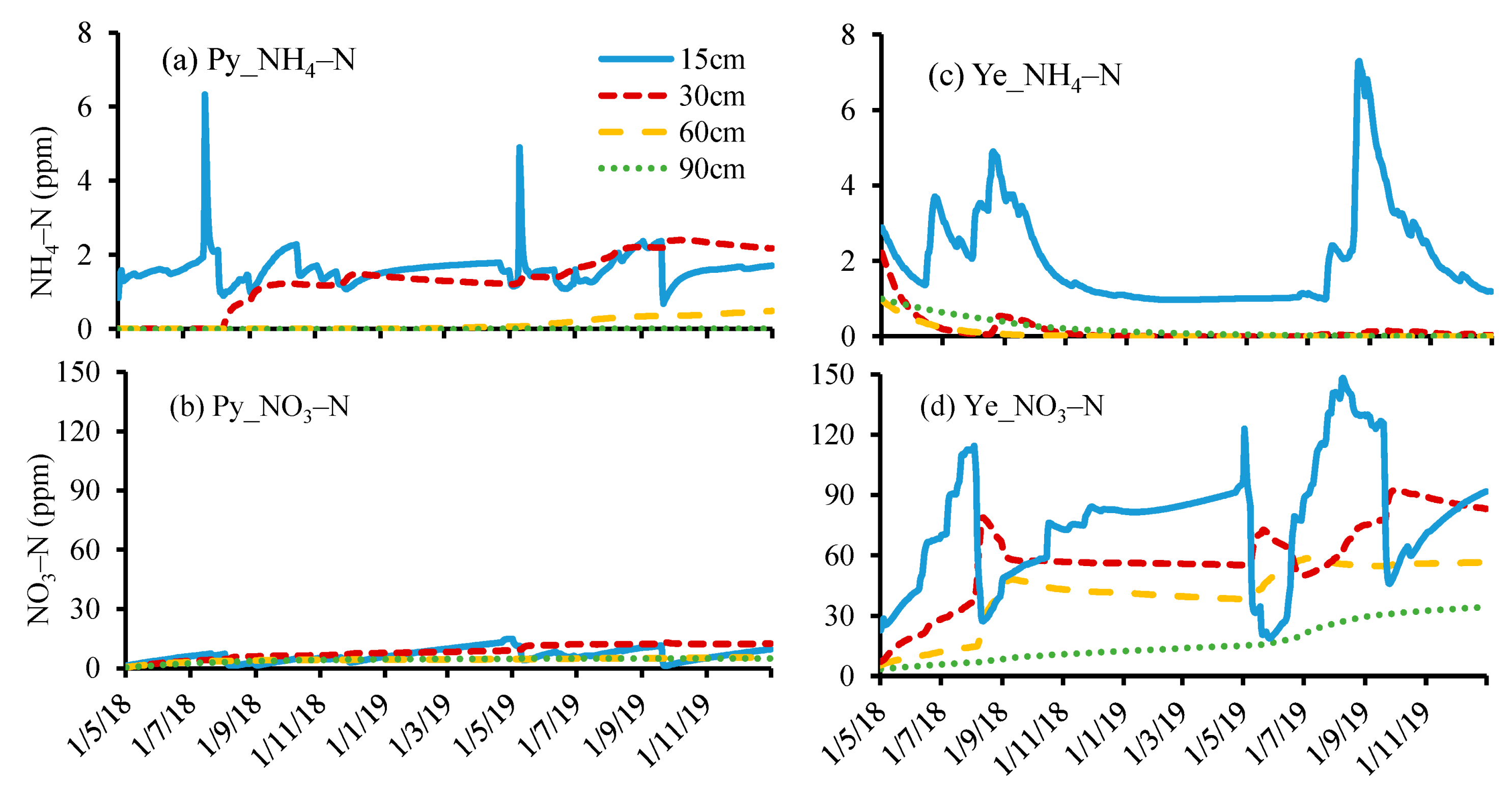

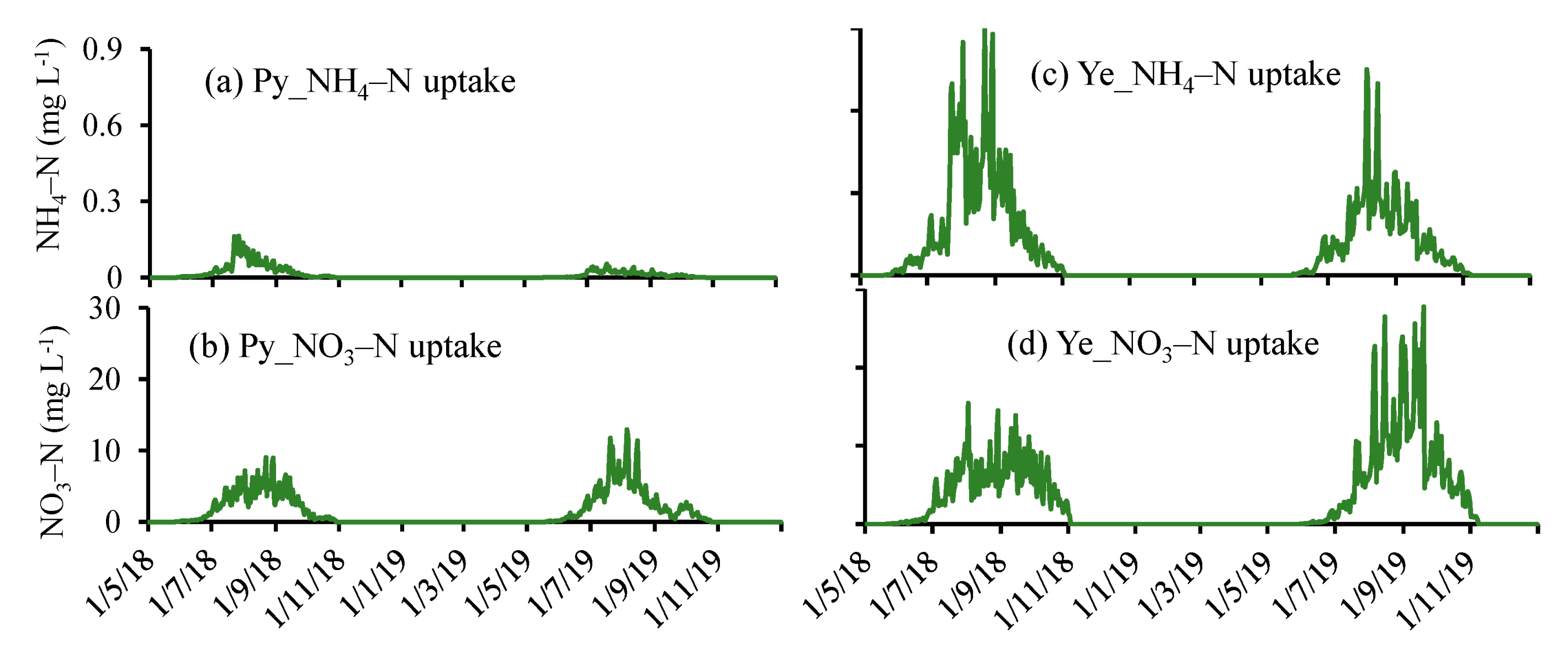
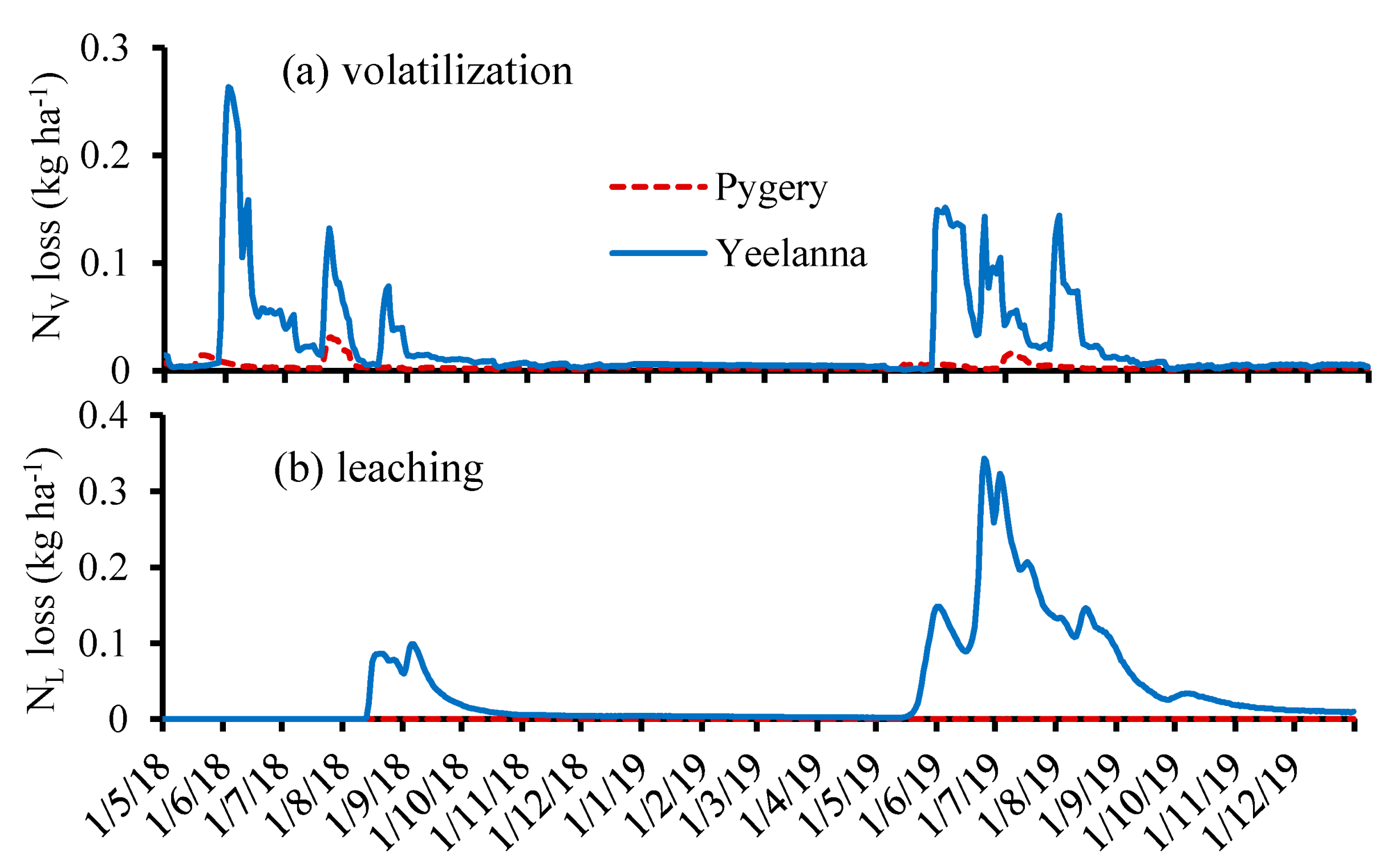
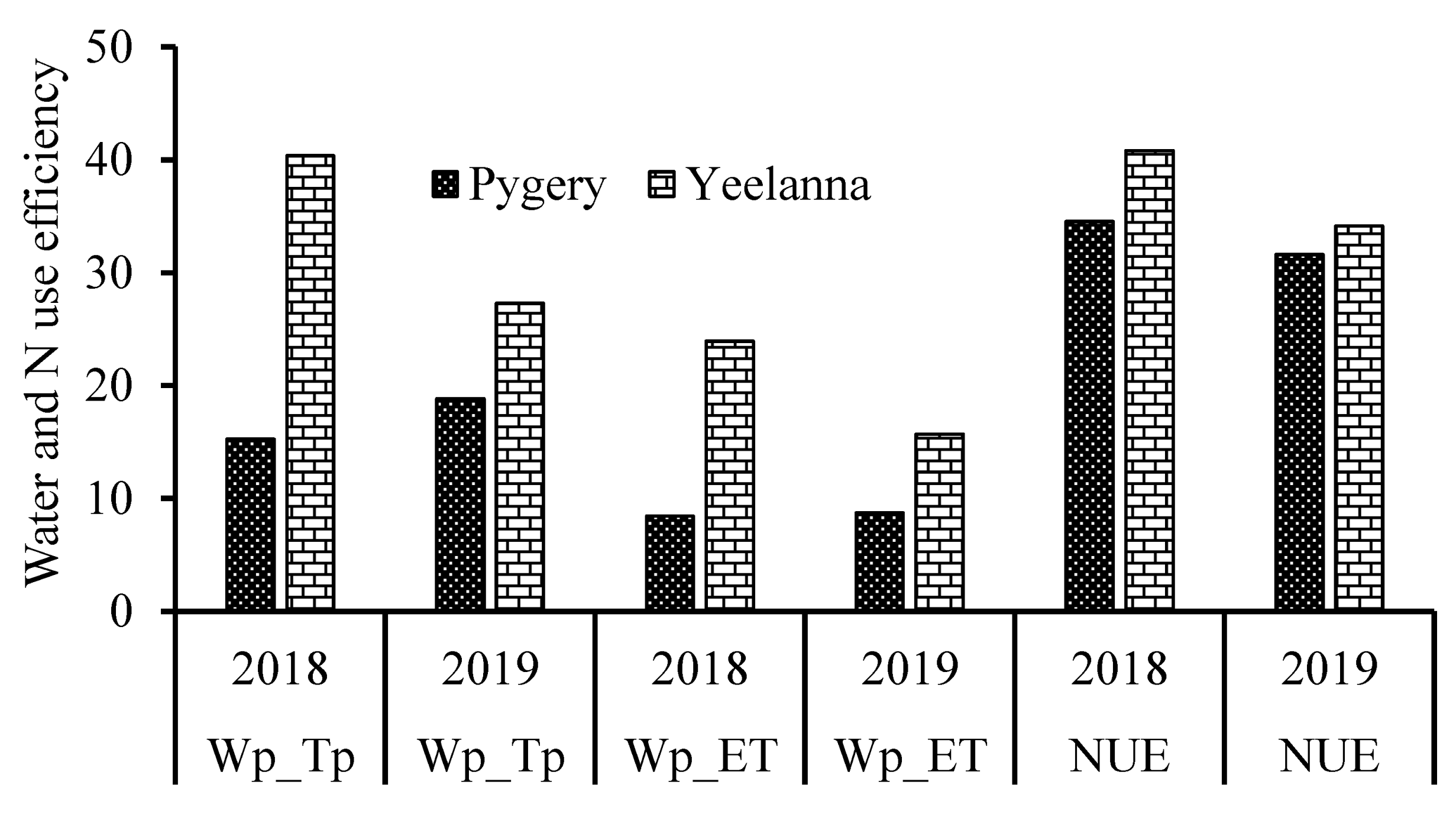
| 2018 | 2019 | |
|---|---|---|
| Pygery (Py) | ||
| Variety | Mace | Mace |
| Sowing date | 19 May | 12 May |
| Row spacing (mm) | ||
| Plant density (plants m−2) | 140 | 160 |
| Fertilizers (applied at sowing) | ||
| MAP (kg ha−1) | 55 | - |
| Urea (kg ha−1) | - | 40 |
| Urea/ammonium sulfate blend | 30 | 60 |
| Yield (t ha−1) | 1.45 | 1.6 |
| Yeelanna (Ye) | ||
| Variety | Emu Rock | Mace |
| Sowing date | 12 May | 22 May |
| Row spacing (mm) | 307 | 305 |
| Plant density (plants m−2) | 150 | 150 |
| Fertilizers (applied at sowing) | ||
| MAP (kg ha−1) | 66 | |
| Urea (kg ha−1) | 100 | 75 |
| In-season fertilizer | ||
| Urea (kg ha−1) and date | 50 on 16 July | 100 on 28 June |
| 50 on 17 August | 100 on 27 July | |
| Yield (t ha−1) | 5.67 | 3.84 |
| Depth (cm) | Soil Texture | Sand | Silt | Clay | Db (g cm−3) | OC (%) | pH (H2O) | pH (CaCl2) | CEC (Cmol (+) kg−1) |
|---|---|---|---|---|---|---|---|---|---|
| % | % | % | |||||||
| Pygery (Py) | |||||||||
| 0–15 | SL | 64.7 | 13.5 | 19.8 | 1.57 | 1.17 | 8.5 | 7.8 | 17.0 |
| 15–30 | SCL | 58.7 | 12.3 | 28.9 | 1.33 | 0.75 | 8.7 | 8.0 | 22.5 |
| 30–60 | SCL | 47.0 | 21.2 | 31.8 | 1.33 | 0.55 | 9.3 | 8.3 | 25.0 |
| 60–90 | CL | 42.7 | 21.2 | 36.0 | 1.42 | 0.34 | 9.5 | 8.5 | 26.2 |
| 90–100 | SC | 45.0 | 19.3 | 35.7 | 1.42 | 0.34 | 9.5 | 8.5 | 24.7 |
| Yeelanna (Ye) | |||||||||
| 0–15 | SCL | 70.4 | 8.7 | 20.9 | 1.45 | 2.03 | 8.1 | 7.7 | 26.1 |
| 15–30 | C | 21.8 | 6.3 | 71.9 | 1.34 | 0.70 | 8.5 | 7.9 | 42.0 |
| 30–60 | C | 22.3 | 6.4 | 71.2 | 1.52 | 0.42 | 8.6 | 8.0 | 45.5 |
| 60–90 | C | 14.3 | 10.2 | 75.6 | 1.64 | 0.32 | 9.3 | 8.3 | 47.2 |
| 90–100 | SC | 51.5 | 3.0 | 45.5 | 1.64 | 0.32 | 9.3 | 8.3 | 51.5 |
| Soil Texture | Soil Depth (cm) | θr (cm3 cm−3) | θs (cm3 cm−3) | a (cm−1) | n | Ks (cm d−1) | l | Db (g cm−3) |
|---|---|---|---|---|---|---|---|---|
| Pygery (Py) | ||||||||
| Loam | 0–15 | 0.05 | 0.40 | 0.024 | 1.40 | 27.1 | 0.5 | 1.57 |
| Loam | 15–30 | 0.12 | 0.41 | 0.022 | 1.32 | 19.1 | 0.5 | 1.33 |
| Clay loam | 30–60 | 0.2 | 0.44 | 0.017 | 1.37 | 15.6 | 0.5 | 1.33 |
| Clay loam | 60–90 | 0.22 | 0.45 | 0.017 | 1.35 | 14.4 | 0.5 | 1.42 |
| Cay loam | 90–105 | 0.24 | 0.45 | 0.018 | 1.35 | 15.8 | 0.5 | 1.42 |
| Yeelanna (Ye) | ||||||||
| Loam | 0–15 | 0.07 | 0.45 | 0.025 | 1.45 | 53.4 | 0.5 | 1.45 |
| Clay | 15–30 | 0.15 | 0.46 | 0.023 | 1.31 | 17.2 | 0.5 | 1.34 |
| Clay | 30–60 | 0.19 | 0.44 | 0.021 | 1.28 | 9.4 | 0.5 | 1.52 |
| Clay | 60–90 | 0.21 | 0.49 | 0.019 | 1.17 | 5.49 | 0.5 | 1.64 |
| Silt loam | 90–105 | 0.24 | 0.49 | 0.018 | 1.16 | 11.1 | 0.5 | 1.64 |
| Site | Year | Soil Depth (cm) | RMSE (cm3 cm−3) | MAE (cm3 cm−3) | ME (cm3 cm−3) |
|---|---|---|---|---|---|
| Pygery | 2018 | 0–30 | 0.02 | 0.01 | −0.01 |
| 30–100 | 0.04 | 0.03 | 0.02 | ||
| 2019 | 0–30 | 0.03 | 0.03 | −0.02 | |
| 30–100 | 0.07 | 0.06 | −0.06 | ||
| Yeelanna | 2018 | 0–30 | 0.06 | 0.02 | 0.04 |
| 30–100 | 0.04 | 0.03 | 0.03 | ||
| 2019 | 0–30 | 0.07 | 0.07 | −0.04 | |
| 30–100 | 0.05 | 0.04 | −0.02 |
| Site | Year | Es | Tp act | Dr | ∆S | Rainfall (Season) | Rainfall (Annual) |
|---|---|---|---|---|---|---|---|
| Py | 2018 | 76.6 | 95.2 | 0.03 | 6.4 | 175.6 | 235.3 |
| 2019 | 98.6 | 85.0 | 0 | −2.8 | 183.6 | 201.8 | |
| Ye | 2018 | 96.3 | 140.5 | 40.8 | 54.9 | 333 | 407.6 |
| 2019 | 104.3 | 140.6 | 90.4 | 9.2 | 348.3 | 375.5 |
Disclaimer/Publisher’s Note: The statements, opinions and data contained in all publications are solely those of the individual author(s) and contributor(s) and not of MDPI and/or the editor(s). MDPI and/or the editor(s) disclaim responsibility for any injury to people or property resulting from any ideas, methods, instructions or products referred to in the content. |
© 2023 by the authors. Licensee MDPI, Basel, Switzerland. This article is an open access article distributed under the terms and conditions of the Creative Commons Attribution (CC BY) license (https://creativecommons.org/licenses/by/4.0/).
Share and Cite
Phogat, V.; Šimůnek, J.; Petrie, P.; Pitt, T.; Filipović, V. Sustainability of a Rainfed Wheat Production System in Relation to Water and Nitrogen Dynamics in the Soil in the Eyre Peninsula, South Australia. Sustainability 2023, 15, 13370. https://doi.org/10.3390/su151813370
Phogat V, Šimůnek J, Petrie P, Pitt T, Filipović V. Sustainability of a Rainfed Wheat Production System in Relation to Water and Nitrogen Dynamics in the Soil in the Eyre Peninsula, South Australia. Sustainability. 2023; 15(18):13370. https://doi.org/10.3390/su151813370
Chicago/Turabian StylePhogat, Vinod, Jirka Šimůnek, Paul Petrie, Tim Pitt, and Vilim Filipović. 2023. "Sustainability of a Rainfed Wheat Production System in Relation to Water and Nitrogen Dynamics in the Soil in the Eyre Peninsula, South Australia" Sustainability 15, no. 18: 13370. https://doi.org/10.3390/su151813370
APA StylePhogat, V., Šimůnek, J., Petrie, P., Pitt, T., & Filipović, V. (2023). Sustainability of a Rainfed Wheat Production System in Relation to Water and Nitrogen Dynamics in the Soil in the Eyre Peninsula, South Australia. Sustainability, 15(18), 13370. https://doi.org/10.3390/su151813370










